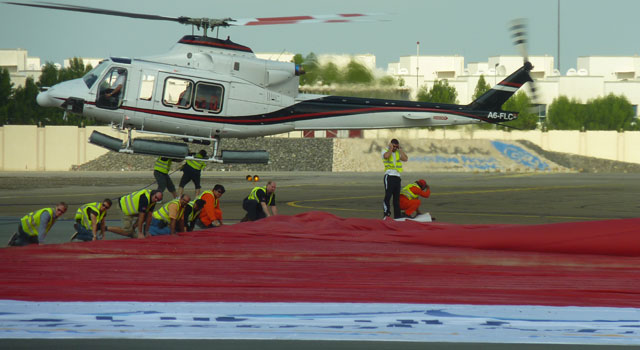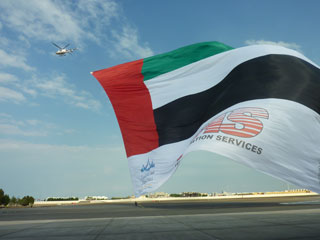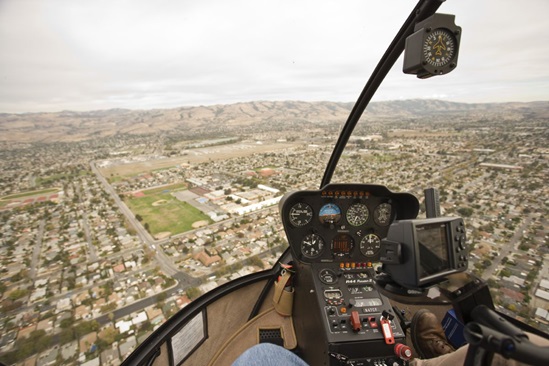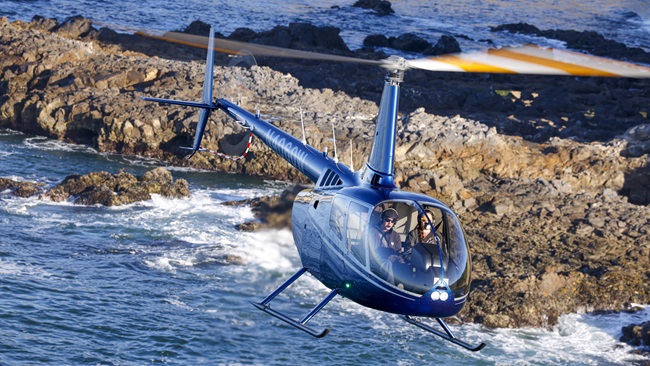
When the United Arab Emirates celebrated 41 years of independence on Dec. 2, participants in the UAE’s National Day observances were treated to the sight of a huge banner featuring the national flag aloft above the waterfront of the Abu Dhabi Corniche.
The banner, towed by a Bell 412 helicopter, measured more than 50,000 square feet, making the flag visible to the entire city of Abu Dhabi. The flag banner’s size made it “the world’s largest aerial banner,” Bell Helicopter said in a news release about the flight.
The aerial display of the flag for National Day celebrations has been the job of helicopter and corporate jet operator Falcon Aviation Services.
“This is our fifth year of flying this amazing flag—and it seems to get bigger every year,” said A.J. Baker, Falcon’s vice president of commercial business.
The Bell 412 utility helicopter has a 220-cubic-foot cabin that can hold 13 passengers and two crewmembers. It is powered by a Pratt & Whitney PT6T-3D Twin Pac engine. Known as a workhorse aircraft, the 412 earns that reputation by flying missions such as “towing the world’s largest aerial banner,” said Danny Maldonado, Bell Helicopter’s executive vice president of sales and marketing.
 Hovering and hooking up
Hovering and hooking up
The size of the flag banner compares to traditional advertising banners that range from 5,000 to 20,000 square feet. Those banners are usually towed by Falcon’s Bell 206 L3 or Eurocopter EC-130 B4 helicopters, said Baker.
“The limitation above this size isn’t really about flying it or the helicopter itself, it is about controlling the banner when on the ground during the launch and recovery phase,” Baker wrote in an email to AOPA describing the tow operation. “Imagine trying to control a football-field-size piece of parachute silk with a total weight of almost 300kgs – it becomes a logistical ‘challenge’ just physically moving it around and then, the slightest breeze can quickly cause control of the banner on the ground to be lost.”
A large bag filled with about 180 kilograms of fine sand acts as a weight for the banner, which connects to the helicopter by a 150-foot-long line.
The banner is laid out perpendicular to the wind direction. Then the Bell 412 enters a hover for the hookup, with the pilot keeping an eye on the proceedings through a vertical-reference door, Baker said.
Falcon uses a team of at least 20 to control the banner on the ground. The team learned—through trial and error, Baker says—that the secret is to position team members along the banner’s leading edge to keep the wind from getting under it.
After hookup, the helicopter “moves into a high hover to take up the length of the long line, and as the top of the leading edge begins to ascend, forward flight is commenced (whilst continuing to climb). The banner is not simply a flat sheet, it has numerous flight pockets and other features (design patent protected) that actually make it ‘fly’ so it will straighten out and hold its shape either in a light breeze or as soon as forward motion is present,” Baker said.
The key to a good launch is to avoid dragging the weight bag too much. 
The banner is towed at about 35 knots. Maximum wind speed for banner operations is 25 knots.
Over water, the helicopter flies at 1,000 feet, which places the bottom of the banner at 500 feet above the surface. Over land, the helicopter flies at 1,500 feet agl, placing the banner’s bottom at 1,000 feet.
In an emergency or uncommanded release, the tow load is designed for a safe descent. A parachute deploys, inverting the weight bag and dispersing its contents. “The banner itself then does a bit of a roman candle and wraps itself up along the long line and the whole lot falls to the ground ‘gently,’” Baker said.
In addition to the towing of the flag banner, other aviation elements of the UAE’s celebration of its 1971 independence included aerobatics displays and hot air balloon rides, Bell Helicopter said.



